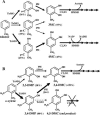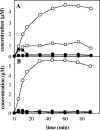Mutation of glutamic acid 103 of toluene o-xylene monooxygenase as a means to control the catabolic efficiency of a recombinant upper pathway for degradation of methylated aromatic compounds
- PMID: 16085871
- PMCID: PMC1183268
- DOI: 10.1128/AEM.71.8.4744-4750.2005
Mutation of glutamic acid 103 of toluene o-xylene monooxygenase as a means to control the catabolic efficiency of a recombinant upper pathway for degradation of methylated aromatic compounds
Abstract
Toluene o-xylene monooxygenase (ToMO) and phenol hydroxylase (PH) of Pseudomonas stutzeri OX1 act sequentially in a recombinant upper pathway for the degradation of aromatic hydrocarbons. The catalytic efficiency and regioselectivity of these enzymes optimize the degradation of growth substrates like toluene and o-xylene. For example, the sequential monooxygenation of o-xylene by ToMO and PH leads to almost exclusive production of 3,4-dimethylcatechol (3,4-DMC), the only isomer that can be further metabolized by the P. stutzeri meta pathway. We investigated the possibility of producing ToMO mutants with modified regioselectivity compared with the regioselectivity of the wild-type protein in order to alter the ability of the recombinant upper pathway to produce methylcatechol isomers from toluene and to produce 3,4-DMC from o-xylene. The combination of mutant (E103G)-ToMO and PH increased the production of 4-methylcatechol from toluene and increased the formation of 3,4-DMC from o-xylene. These data strongly support the idea that the products and efficiency of the metabolic pathway can be controlled not only through mutations that increase the catalytic efficiency of the enzymes involved but also through tuning the substrate specificity and regioselectivity of the enzymes. These findings are crucial for the development of future metabolic engineering strategies.
Figures




Similar articles
-
Regiospecificity of two multicomponent monooxygenases from Pseudomonas stutzeri OX1: molecular basis for catabolic adaptation of this microorganism to methylated aromatic compounds.Appl Environ Microbiol. 2005 Aug;71(8):4736-43. doi: 10.1128/AEM.71.8.4736-4743.2005. Appl Environ Microbiol. 2005. PMID: 16085870 Free PMC article.
-
Protein engineering of toluene-o-xylene monooxygenase from Pseudomonas stutzeri OX1 for enhanced chlorinated ethene degradation and o-xylene oxidation.Appl Microbiol Biotechnol. 2005 Sep;68(4):510-7. doi: 10.1007/s00253-005-1923-4. Epub 2005 Oct 26. Appl Microbiol Biotechnol. 2005. PMID: 15696279
-
Phenol hydroxylase and toluene/o-xylene monooxygenase from Pseudomonas stutzeri OX1: interplay between two enzymes.Appl Environ Microbiol. 2004 Apr;70(4):2211-9. doi: 10.1128/AEM.70.4.2211-2219.2004. Appl Environ Microbiol. 2004. PMID: 15066815 Free PMC article.
-
Substrate trafficking and dioxygen activation in bacterial multicomponent monooxygenases.Acc Chem Res. 2007 Jul;40(7):466-74. doi: 10.1021/ar600040e. Epub 2007 May 23. Acc Chem Res. 2007. PMID: 17518435 Review.
-
Enzymes involved in the aerobic bacterial degradation of N-heteroaromatic compounds: molybdenum hydroxylases and ring-opening 2,4-dioxygenases.Naturwissenschaften. 2000 Feb;87(2):59-69. doi: 10.1007/s001140050011. Naturwissenschaften. 2000. PMID: 10663136 Review.
Cited by
-
X-ray structure of a hydroxylase-regulatory protein complex from a hydrocarbon-oxidizing multicomponent monooxygenase, Pseudomonas sp. OX1 phenol hydroxylase.Biochemistry. 2006 Dec 26;45(51):15392-404. doi: 10.1021/bi0618969. Epub 2006 Dec 2. Biochemistry. 2006. PMID: 17176061 Free PMC article.
-
Tuning the specificity of the recombinant multicomponent toluene o-xylene monooxygenase from Pseudomonas sp. strain OX1 for the biosynthesis of tyrosol from 2-phenylethanol.Appl Environ Microbiol. 2011 Aug;77(15):5428-37. doi: 10.1128/AEM.00461-11. Epub 2011 Jun 10. Appl Environ Microbiol. 2011. PMID: 21666013 Free PMC article.
-
Alterations of the Intestinal Permeability are Reflected by Changes in the Urine Metabolome of Young Autistic Children: Preliminary Results.Metabolites. 2022 Jan 23;12(2):104. doi: 10.3390/metabo12020104. Metabolites. 2022. PMID: 35208179 Free PMC article.
-
Molecular determinants of the regioselectivity of toluene/o-xylene monooxygenase from Pseudomonas sp. strain OX1.Appl Environ Microbiol. 2009 Feb;75(3):823-36. doi: 10.1128/AEM.01951-08. Epub 2008 Dec 12. Appl Environ Microbiol. 2009. PMID: 19074607 Free PMC article.
-
Toward functional carboxylate-bridged diiron protein mimics: achieving structural stability and conformational flexibility using a macrocylic ligand framework.J Am Chem Soc. 2011 Jul 13;133(27):10568-81. doi: 10.1021/ja2021312. Epub 2011 Jun 17. J Am Chem Soc. 2011. PMID: 21682286 Free PMC article.
References
-
- Fetzner, S., and J. R. van der Meer. 2000. Enzymes involved in the aerobic bacterial degradation of N-heteroaromatic compounds: molybdenum hydroxylases and ring-opening 2,4-dioxygenases. Naturwissenschaften 87:59-69. - PubMed
Publication types
MeSH terms
Substances
LinkOut - more resources
Full Text Sources

